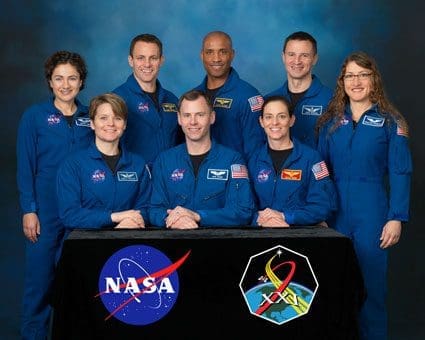
For as long as she can remember, Christina Hammock Koch would look up at the night sky and dream of traveling among the stars. Even the destruction of the space shuttle Challenger and the loss of the crew, which Koch watched live with her first grade classmates in 1986, never dissuaded her from her dream.
“Seeing that our country was mourning something that was kind of big enough and important enough to do, but that was also dangerous and challenging, I think that caught my attention, even at that young age,” Koch said. “If anything, it was ‘Let’s get back into space.’ ”

While becoming an astronaut, like being a professional athlete or movie star, might be one of those dreams that children outgrow, Koch never did. The Jacksonville native was fortunate enough to attend the North Carolina School of Science and Mathematics for her high school education, grounding her in the fundamentals she would later need to pursue her dream of joining NASA.
“Everyone around me was really smart,” Koch told a crowd at the Museum of Natural Sciences in Raleigh. “They were from fancy places like Charlotte or Raleigh. This was the first time I got a taste of something I’ve tried to hold onto – using intimidation or feeling scared to actually fuel your success, to turn it around and use that as motivation to achieve what you might not have thought was possible before.”
While Koch now serves as one of four females in a recent class of eight NASA astronauts – the first time half of the class is made up of women – she got her first exposure to the space agency while a student at NCSSM when she attended space camp, which included a session on how to become an astronaut and a checklist of steps to follow that course.

Before getting ready to explore the stars, however, Koch decided she wanted to explore the Earth first. While studying for a double major of electrical engineering and physics at North Carolina State University, she took a semester in 1999 to study abroad in Ghana. When she got there she learned that the university was no longer offering many of the courses she planned to take, but she decided to stay in the country and teach local students. The space dream remained strong in Koch, who wrote about it in an essay for a scholarship application.
After graduating from NC State, Koch went to work for NASA – as an electrical engineer at the Goddard Space Flight Center’s Laboratory for High Energy Astrophysics in Greenbelt, Maryland. But rather than stay with NASA, she took jobs that gave her the opportunity to work in far out-of-the-way locations, such as Greenland and Antarctica, where conditions were minus-105 degrees at the South Pole. Despite the cold, being in Antarctica rekindled her love of watching the sky.
“When you have a sky full of that many stars, absolute darkness, all of the stars come out, and you have the Southern Lights, the auroras,” she said. “I absolutely loved it.”
In 2011, she decided to apply for NASA’s next class of astronauts – one of more than 6,000 to do so. As the agency whittled down the applicants to a list of 120, then to 50, Koch kept making the grade. Beyond her academic achievements, NASA interviewers were interested in the other aspects of her life that showed her as well-rounded and more likely to fit in a team atmosphere.
“Interestingly, the one thing the interview committee wanted to talk to me most about wasn’t electrical engineering; it was rock climbing, and working in Antarctica and all these other experiences that I had that were part of my path to get there,” – Christina Koch.
Koch was working in American Somoa for the National Oceanic and Atmospheric Administration when she learned she made the final cut for the newest class of astronauts. She began training with seven other candidates at the Johnson Space Center that summer.
The astronauts underwent two years of training and come from diverse backgrounds with diverse skillsets. Koch, unlike many of the famous pioneer astronauts, has no training as a pilot nor a military background. Training included everything from hiking difficult terrain in the wilderness to spending up to six hours under water learning how to move around in a weightless environment in a spacesuit.
“It’s just physically hard to move,” said Koch, who had to put padding into her suit to make it fit because the spacesuits were designed for men. “Every little motion you do is difficult.”
Much of the training involves learning how to use the latest gadgets and gear developed for NASA. One of the primary duties of the class is to give feedback to NASA engineers on various tools that are being used in the International Space Station. They also provide other support roles, since it might be years before this particular class of astronauts makes it into space.
While waiting her turn to travel to the stars, the dream burns as brightly as ever inside Koch.
“Some things do just turn into your normal workday – getting into a spacesuit, blah, blah, blah,” she said. “In some ways, you get used to it. But in other ways, you have moments when you realize how amazing it is. Day to day, we’re still excited.”
–Compiled from reports from the North Carolina School of Science and Mathematics and North Carolina State University